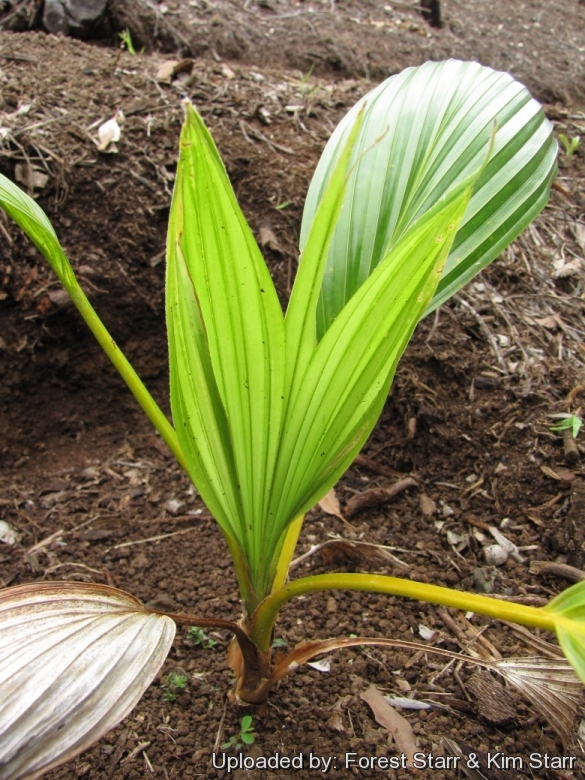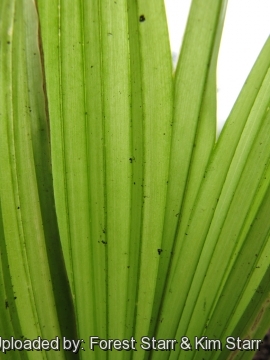




Your support is critical to our success.

Origin and Habitat: Endemic to Maui in the Hawaiian Islands archipelago (North-Central Pacific, USA)
Habitat: Moist to wet forest.
Altitude: 700-1000 m above sea level.
Synonyms:
- Pritchardia woodii Hodel
ENGLISH: Wood's pritchardia
HAWAIIAN (ʻŌlelo Hawaiʻi): Wāhane, Hāwane, Loulu
Description: Pritchardia woodii is a medium sized solitary palm similar to Pritchardia lanigera
Trunk: Single-stemmed up to 15 m tall, 20-25 cm diameter, greyish, longitudinally grooved.
Crown: Round with a whorl of 15-20, erect to spreading fronds.They are fan-shaped.
Leaves: Costapalmate 80-130 x 100-145 cm, forming a semi-circle, the leaf blade is licate (folded like a fan from the base to the tips of the leaf), divided into stiff, single-fold segments with erect, bifid leaf segment tips. The leaf colour is glossy light green with white to tan mealy indumentum on the lower surfaces. Petiole 60-105 cm long. The leaf sheath breaks down into a mass of tawny fibres.
Inflorescence:* Large, compact, many branched, panicle, 75-135 cm long, erect and shorter than or equalling petioles. The flowers are arranged spirally along the branches that are densely covered with greyish brown, short, velvety hairs. Flowers three-petaled and pale yellow or greenish yellow.
Fruit: 45-50 x 40-45 mm, ovoid to ellipsoid, greenish, sometimes warty.
Bibliography: Major references and further lectures
1) Forest & Kim Starr Pritchardia woodii (Wood's pritchardia). Plants of Hawaii. <http://www.starrenvironmental.com>. Downloaded on 21 August 2014.
2) "Pritchardia." PACSOA Palms and Cycads wiki , <http://www.pacsoa.org.au> Accessed on 28 Aug. 2014
3) David Leaser "Growing Palm Trees in Hawaiʻi and Other Tropical Climates", page 78.
4) Heidi Leianuenue Bornhorst “Growing Native Hawaiian Plants: A How-to Guide for the Gardener” Bess Press, 01/Apr/2005
5) Palmpedia contributors. "Pritchardia." Palmpedia, PALM ENCYCLOPEDIA, <http://www.palmpedia.net> Downloaded on 26 Aug. 2014
6) Wikipedia contributors. "Pritchardia." Wikipedia, The Free Encyclopedia. Wikipedia, The Free Encyclopedia, 21 Jan. 2014. Web. 5 Sep. 2014.
7) Chapin, M.H., K.R. Wood, S.P. Perlman, and M. Maunder. 2004. A review of the conservation status of the endemic Pritchardia palms of Hawai‘i. Oryx 38(3): 273-281.
8) Hodel, D.R. 2007. A Review of the Genus Pritchardia. Palms 51(supplement): S1-S52.
9) Neal L. Evenhuis "Natural History of Nihoa and Necker Islands" by, 46, 62-63
12) Donald R. Hodel "Loulu--The Hawaiian Pritchardia" by, The Palm Journal 193, pages 10, 12.
13) Rerioterai Tava "Niihau--The Traditions of an Hawaiian Island" by, pages 32, 34, 63.

Pritchardia woodii Photo by: Forest Starr & Kim Starr
The gallery now contains thousands of pictures, however it is possible to do even more. We are, of course, seeking photos of species not yet shown in the gallery but not only that, we are also looking for better pictures than those already present. Read More...
Cultivation and Propagation: It likes organic soil, but is adaptable. Good drainage is also important. Pritchardia woodiiSN|24656]]SN|24656]] vary in shape. Specimens raised in dry and/or infertile soils tend to be smaller in stature with smaller leaves. Light also affects the plant's form while those grown in full sun are more compact. Tough they may be slow growing while young, once established, they will grow relatively fast.
Fertilization: Need a perfect fertilizer diet including all micro nutrients and trace elements or slow release fertilizer. Micronutrient deficiencies are occasional problems. If it doesn't get enough Mn and Fe, the leaves take on a rather unhealthy yellow colour. Micronutrient deficiencies only show up on soil with a high pH. Fertilize often for faster growth.
Water Requirements: Needs regular water, do not let dry out between waterings. however it does not want to sit in continually wet, mucky soil. The roots and lower trunk can rot if soil is kept too moist.
Light: Prefers full sun but will tolerate half day sun.
Hardiness: It is adapted to tropical and subtropical climates.
Maintenance: Prune diseased, damaged or drying fronds, but do not prune if the frond still has some green colour. Palms recycle nutrients from dead or dying fronds and use them for healthier fronds. Palms only have a set number of new leaves that can sprout and grow per year and removing fronds will not increase that number. If you cut off more than what will grow annually, you could be left with a pretty bare and bald palm.
Early Hawaiian Use The hard wood of the trunk were fashioned into spears. The trunks loulu were notched for climbing to gather the immature fruits and fronds. Older specimens still bear notches that can be seen today. The fronds were used for thatching and as plaiting such as hats and fans.
Ornamental: It is rarely cultivated as an ornamental tree, and planted in gardens and parks in tropical and sub-tropical climates either as a single specimen or in groups. Culture in containers is possible although growth rates are slower. A bright patio will provide an excellent environment for young specimens which can eventually be planted in a sunny location.
Propagation: Seeds. Because these palms easily hybridize with other Pritchardias, claiming a specific species requires seed collection from wild populations.
| Your Actions | |
|---|---|
| Back to Pritchardia index | |
| Back to Arecaceae index | |
 |
Back to Palms And Cycads Encyclopedia index |
Privacy stantement - Terms and conditions - How to cite - About us - Feedback - Donate


